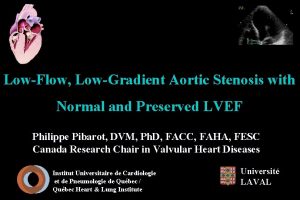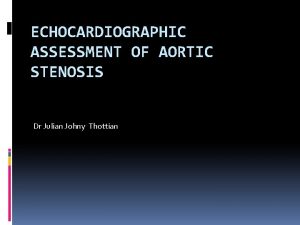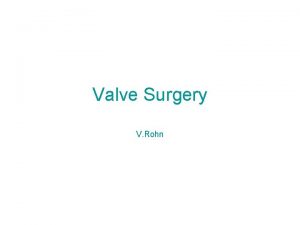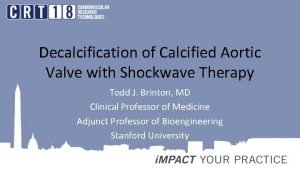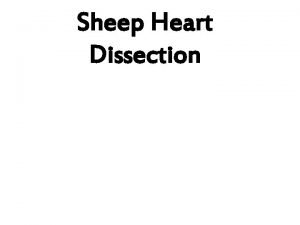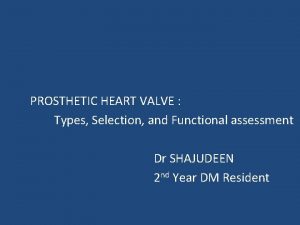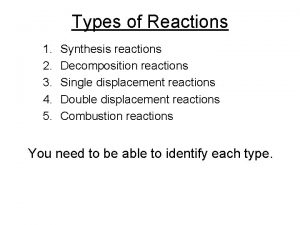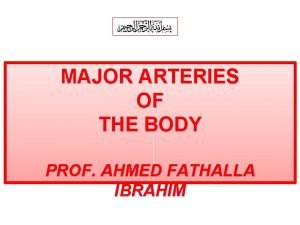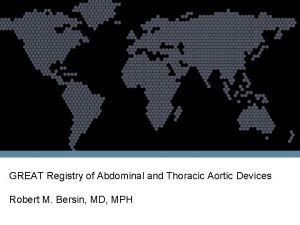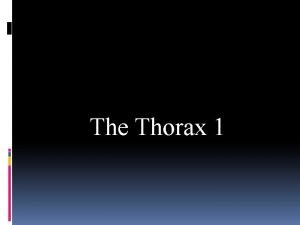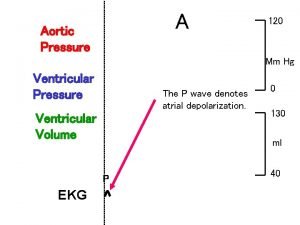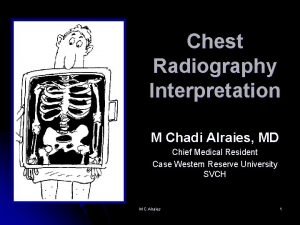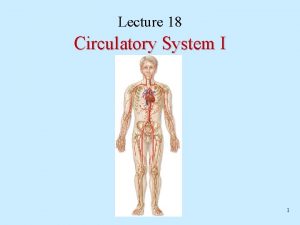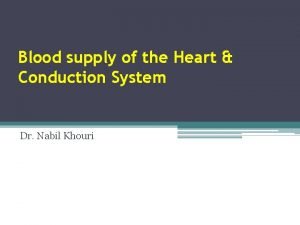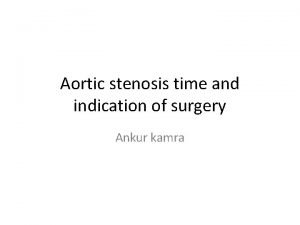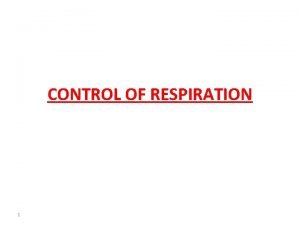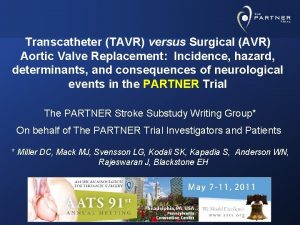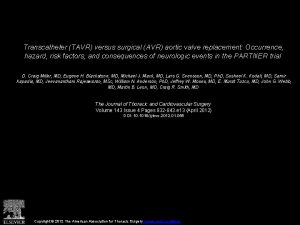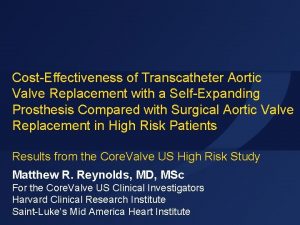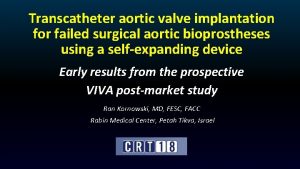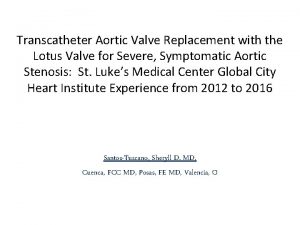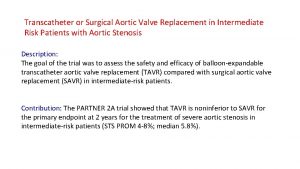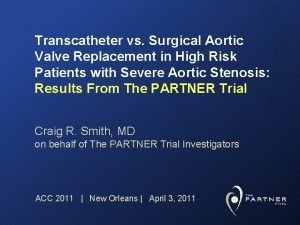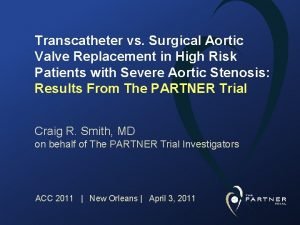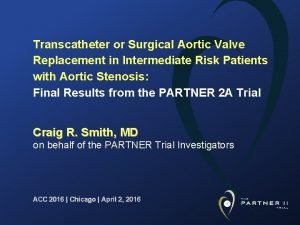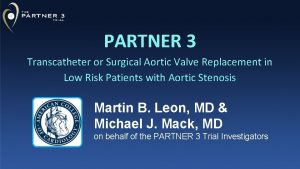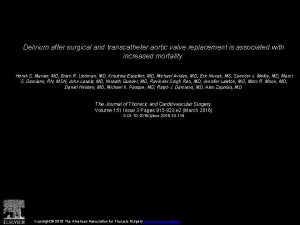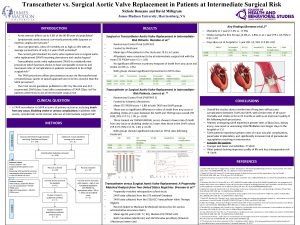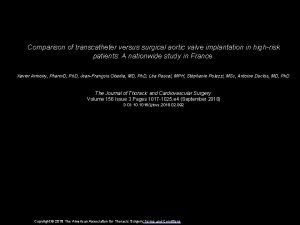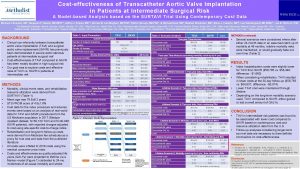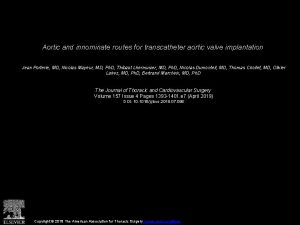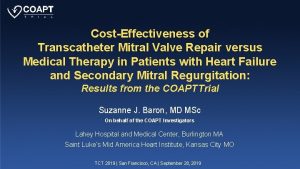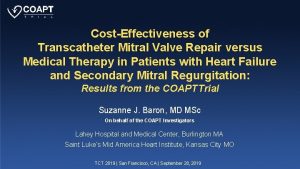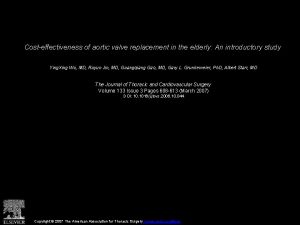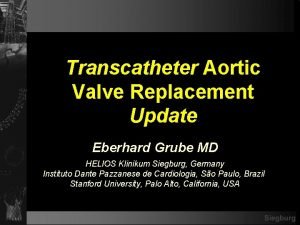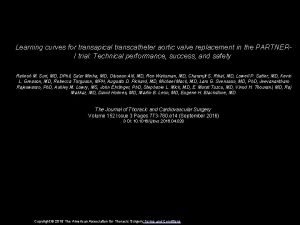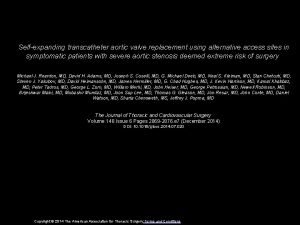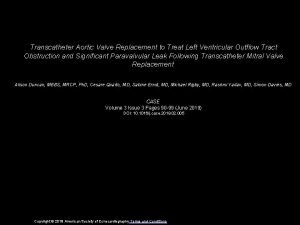CostEffectiveness of Surgical Aortic Valve Replacement versus Transcatheter

























- Slides: 25

Cost-Effectiveness of Surgical Aortic Valve Replacement versus Transcatheter Aortic Valve Replacement Using Registry Data Christopher U. Meduri, MD Matthew R. Reynolds, Philippe Généreux, Andrew N. Rassi, David A. Burke and Jeffrey J. Popma American College of Cardiology Annual Scientific Sessions March 11 th, 2013

Background • PARTNER Cohort A is the only randomized-control trial evaluating TAVR vs. SAVR in high-risk patients. • The 12 -Month cost-effectiveness analysis in the PARTNER Cohort A study (TAVR vs. SAVR) showed: ² Transfemoral (TF)-TAVR vs. SAVR: ∆ QALYs = + 0. 06; ∆ Cost = - $2, 210 ² Transapical (TA)-TAVR vs. SAVR: ∆ QALYs = - 0. 07; ∆ Cost = + $9, 595. • Detailed cost-effective analysis has not been extensively evaluated in “real world” patients undergoing TAVR and SAVR. Reynolds MR, Cohen DJ JACC 2012

Objectives • To determine the cost-effectiveness of TAVR compared with high-risk isolated SAVR outside of RCTs. • To explore potential differences in the cost-effectiveness of TF-TAVR and TA-TAVR compared with isolated SAVR. • To identify the influence of varying rates of procedural complications on the cost-effectiveness of TF-TAVR, TATAVR and SAVR.

Methods • Markov decision analytic model (Tree. Age Pro software) with Monte Carlo simulations. • Model informed with: Ø Outcome Probabilities: Derived from meta-analysis of 20 TAVR Registries and 8 isolated SAVR Registries. Ø Costs: Utilized PARTNER A CEA and current literature review of costs of complications. Ø Quality of Life: Utilized PARTNER A CEA and current literature review of Qo. L related to complications. • All cost and benefits discounted at 3%. • Probabilities and utilities in Beta-distributions. • Lifetime model with mortality after year 1 from adjusted US lifetables based on changes in mortality from year 1 to 2 in TAVR registry.

Markov Model 30 -Day 1 -Year Annual Well Die Alive TAVR Major Stroke Die Minor Stroke Symptomatic Severe Aortic Stenosis New Dialysis SAVR (Clone of TAVR) Vascular Complication New PPM

Registry Data Meta-Analysis Variable (# Studies) TAVR-All (20) TF-TAVR (7) TA-TAVR (5) Isolated SAVR (8) Patients (#) 15, 691 10, 311 3, 097 2, 046 Age (Years) 82. 0 81. 7 81. 5 78. 5 Female (%) 50. 7 54. 4 48. 0 51. 3 Mean Logistic Euro. SCORE 21. 3 21. 0 22. 7 21. 5 Mean STS Score 11. 8 14. 2 13. 2 12. 2 NYHA III-IV (%) 86. 8 81. 1 81. 3 65. 0

Registry Data Meta-Analysis Variables 30 -Day Mortality TAVR (%) 7. 6 1 -Year Mortality TF-TAVR (%) TA-TAVR (%) SAVR (%) 5. 9 9. 5 9. 4 18. 2 15. 8 23. 7 18. 4 30 -Day to 1 -Year Mortality 10. 6 9. 9 14. 2 9. 0 Major Stroke 2. 5 2. 1 2. 5 3. 8 Minor Stroke 1. 1 1. 5 2. 2 2. 5 Vascular Complication 12. 3 13. 8 2. 5* 2. 5 New Dialysis 1. 7 4. 0 Pacemaker 16. 2 19. 0 8. 9 7. 7 *Vascular Complications for Cardiac Surgery were not available from registry data so a vascular complication rate was imputed from TA-TAVR.

Costs Access In Hospital ($) • Annual ($) TAVR SAVR TF 61, 162 59, 687 10, 687 14, 000 5, 558 TA 74, 421 61, 395 18, 098 24, 963 5, 558 Major Stroke Minor Stroke Vascular Complications Dialysis Pacemaker • • Hospital to 12 months ($) In Hospital ($) 14, 155 8, 658 10, 037 5, 616 13, 845 Annual ($) 14, 561 2, 924 300 30, 365 76 In hospital, hospital to 12 months and annual cost derived from median costs from PARTNER A CEA. Each upfront cost provided for in hospital/30 d cost. After that patients given annual cost x 11/12 for first year, then full cost annually. Annual TAVR/SAVR Annual Cost (after year 1) made the same, based on average of median outpatient cost in year one for TF/SAVR arm of PARTNER A.

Utilities One-Month Variable Well Major Stroke Minor Stroke Dialysis One-Year Variable All TAVR 0. 74 0. 237 0. 525 0. 518 All TAVR Transfemoral TAVR 0. 74 0. 237 0. 525 0. 518 Transapical TAVR 0. 68 0. 213 0. 483 0. 476 Isolated SAVR 0. 68 0. 213 0. 483 0. 476 Transapical TAVR 0. 73 Isolated SAVR 0. 74 Well 0. 75 Transfemoral TAVR 0. 75 Major Stroke 0. 24 0. 234 0. 237 Minor Stroke 0. 533 0. 518 0. 525 Dialysis 0. 525 0. 511 0. 518 • All Well Utilities based on results of PARTNER A CEA. • Utilties for Major Stroke (0. 32), Minor Stroke (0. 71) and Hemodialysis (0. 70) were mutliplied times Well utilities to inform our model. • Disutilities were assigned for New Pacemaker (3 days) and Vascular Complication (1 week).

Transfemoral TAVR v. SAVR . More Effective, More Cost Less Effective, More Cost ∆ Cost = - $1110 ∆ QALYs = + 0. 36 ICER = dominant Less Effective, Less Cost % <$50, 000 per QALY = 92. 8% More Effective, Less Cost

Sensitivity Analysis: Transfemoral Cohort Variable 30 -Day Mortality Rate TAVR Threshold to Meta-Analysis Exceed ICER Rate >$50, 000 Mortality increase 5. 9% to 13. 3% Major Stroke Rate Major stroke rate TAVR increased to 8. 1% Vascular No Effect Complications Rate TAVR New Pacemaker Rate TAVR No Effect 2. 5% 13. 8% 19%

Transapical TAVR v. SAVR Less Effective, More Cost % <$50, 000 per QALY = 11. 2% More Effective, More Cost ∆ Cost = + $2995 ∆ QALYs = - 0. 22 ICER = dominated Less Effective, Less Cost More Effective, Less Cost

Sensitivity Analysis: Transapical Cohort Variable Threshold to Reduce ICER < $50, 000 Meta-Analysis Rate and Costs 30 -Day Mortality Rate TAVR Mortality reduced to 2. 6% 9. 5 % In-Hospital Cost TAVR Cost of Hospitalization Reduced by $14, 041 $74, 421

The Learning Curve of Transapical? Partner A Transapical Continued Access Registry Outcome TA-Partner A TA-Continued Access SAVR (Current Registry) 30 d mortality 8. 7 8. 2 9. 4 1 yr mortality 29. 1 23. 6 18. 4 30 d-1 yr 22. 1 10. 9 9 Stroke 7 2 3. 8 Variable Patients (#) Age (Years) Female (%) Mean Logistic Euro. SCORE Mean STS Score NYHA III-IV (%) TA-Partner A CA 822 84. 7 53. 4 28. 4 12. 2 94. 8 *Partner A Transapical Continued Access Registry excluded from our meta-analysis because it is not published. Dewey T STS 2012

TA TAVR Using PARTNER A Continued Access Transapical Data Less Effective, More Cost % <$50, 000 per QALY = 36. 1% More Effective, More Cost ∆ Cost = + $4437 ∆ QALYs = + 0. 02 Less Effective, Less Cost More Effective, Less Cost

Limitations • This is a non-randomized analysis from registry data, and as such it is possible that both identified and unidentified confounders may have influenced the outcomes. • Costs and quality of life were not directly obtained and instead outcome and cost data were derived from PARTNER A CEA and literature review. • Comparison of TA to SAVR outcomes in this observational study is limited by unmeasured confounding related to choice of access route. • The actual rate of complications, apart from death, beyond 30 days is not available in observational databases for these cohorts.

Summary • In this analysis of “real world” high-risk registries, transfemoral TAVR is an economically dominant strategy compared with isolated SAVR • This Markov model supports the PARTNER A CEA, though the magnitude is greater in the real world than seen in RCTs. • Sensitivity analyses suggest that with significantly increased rates of major stroke (up to 8%), vascular complications or pacemaker implantation, transfemoral TAVR remains preferred.

Summary • In contrast, SAVR is economically preferrable to transapical TAVR in high-risk patients. • However, accounting for the “learning curve” demonstrated in the PARTNER A Transapical Continued Access Registry, transapical TAVR become an economically more acceptable option for high risk patients.

Conclusions • Markov modeling is an effective tool to evaluate the cost-effectiveness of TAVR in high risk patients reported in real world clinical registries.

Acknowledgements Jeff Popma, M. D. Matt Reynolds, M. D. , M. Sc. Philippe Généreux, M. D. David Cohen, M. D. , M. Sc. Myriam Hunink, M. D. , Ph. D Brian Potter, M. D. Duane Pinto, M. D, MPH David Burke, M. D. Andrew Rassi, M. D.

To contact author: cmeduri@bidmc. harvard. edu

Backup Slides

Base Case Summary For All Patients: • TAVR provided 5. 28 QALYs and Cost $108, 660 • SAVR provided 5. 07 QALYs and Cost $111, 036 TAVR is an economically DOMINANT strategy compared with SAVR: • Improvement of 0. 21 QALYs • Cost Savings of $2, 376

Transfemoral TAVR Using PARTNER A Stroke Rate . Less Effective, More Cost More Effective, More Cost ∆ Cost = + $3227 ∆ QALYs = + 0. 20 Less Effective, Less Cost More Effective, Less Cost

Vascular Complication Rate (%) 2 -Way Sensitivity Analysis for Stroke and Vascular Complications 50 40 Favors SAVR Favors TAVR 30 20 10 0 3 6 9 Stroke Rate (%) 12 15
 Dvi aortic valve
Dvi aortic valve Heart vein
Heart vein Dvi aortic valve
Dvi aortic valve Aortic stenosis echo criteria
Aortic stenosis echo criteria Aortic valve anatomy
Aortic valve anatomy Aortic valve dimensionless index
Aortic valve dimensionless index Aortic semilunar valve sheep heart
Aortic semilunar valve sheep heart Dvi aortic valve
Dvi aortic valve Aortic valve leaflets
Aortic valve leaflets Combustion reaction formula
Combustion reaction formula Difference between proportional valve and servo valve
Difference between proportional valve and servo valve Main arteries in the body
Main arteries in the body Robert bersin md
Robert bersin md 4th aortic arch derivatives
4th aortic arch derivatives Annulus of vieussens
Annulus of vieussens Mitral regurgitation murmur
Mitral regurgitation murmur Www.youtube.comwatch
Www.youtube.comwatch Thorasic aortic aneurysm
Thorasic aortic aneurysm Thoacic
Thoacic Semilunar
Semilunar X-ray
X-ray Branches off aortic arch
Branches off aortic arch Anterior surface of heart
Anterior surface of heart Thebasian veins
Thebasian veins Dobutamine dose
Dobutamine dose Aortic body
Aortic body
